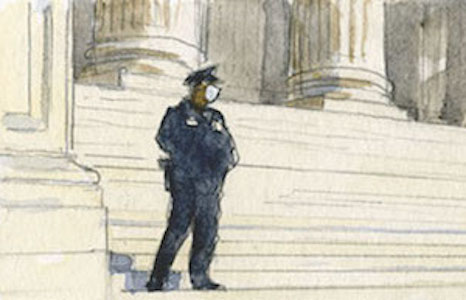Court reinstates Oregon ballot-initiative rules


For the fifth time this year, the Supreme Court set aside a lower-court order that would have altered state election rules in response to the coronavirus pandemic. The justices on Tuesday granted an emergency request by the state of Oregon to put on hold a ruling by a federal district judge that would have required the state to relax its requirements for getting a proposed amendment to the states constitution on the ballot in the November election. Two justices Ruth Bader Ginsburg and Sonia Sotomayor indicated that they would have denied the states request.
Under Oregon law, voters can propose constitutional amendments that will be put up for a statewide vote. Supporters of a proposed amendment must collect enough signatures that the total number equals 8% of the votes cast in the states most recent governors race. Those signatures must be filed with Oregons secretary of state no later than four months before the election. For the 2020 election, that meant that a petition for a proposed amendment needed just under 150,000 signatures by July 2.
Tuesday’s ruling came in a case involving Initiative Petition 57, which proposes to amend Oregons constitution to create an independent commission for redistricting in the state. Civil rights and voting groups supporting the amendment filed a lawsuit on June 30, after proponents had obtained only 64,000 unverified signatures. They claimed that the states rules for getting an amendment on the ballot violated the First Amendment by making it too difficult to place the amendment up for a vote during the pandemic. U.S. District Judge Michael McShane ordered the state to put the proposed amendment on the November ballot if its supporters submitted 58,789 valid signatures nearly 100,000 fewer than would normally be required by Aug. 17.
The state appealed to the U.S. Court of Appeals for the 9th Circuit, which declined to put McShanes order on hold until it could weigh in. That prompted the state to come to the Supreme Court last week, asking the justices to block the order relaxing the states rules. If the order were left in place, the state warned, it could result in the inclusion in the states constitution of an amendment that does not meet the constitutional requirements for appearing on the ballot. Moreover, the state added, the Supreme Courts intervention was necessary because it was not clear whether the 9th Circuit would rule on the appeal before the end of August, when state officials must finalize the November ballot. After that, the state told the justices, it will be extraordinarily difficult to reverse course without having an adverse effect on military and overseas voters.
The proponents of the amendment argued that the state did not have legal standing to challenge McShanes order because Oregons secretary of state Republican Beverly Clarno had chosen not to appeal. Rather, Oregons appeal and its subsequent emergency request to the Supreme Court were pursued by the states attorney general, Democrat Ellen Rosenblum. The amendments proponents said Rosenblums role was improper. And in any event, they continued, McShanes order simply provided sensible and modest relief from the states pre-pandemic rules, especially when measures put in place to combat the pandemic largely prohibited them from gathering signatures in person. There was no need for the Supreme Court to intervene, they argued, because there was plenty of time for the 9th Circuit to issue its decision and, if necessary, for the state to make changes to the ballot.
On Friday, Justice Elena Kagan directed the state to file a short supplemental brief and tell the justices in 100 words or fewer whether Clarno agreed to have Rosenblum represent her and appear on her behalf in the Supreme Court. Clarno responded (if somewhat lukewarmly) that she did. Clarnos consent to the appearance should not be taken as her personal agreement as a policy matter with the attorney generals request, the state wrote. But to the extent that consent to the appearance is necessary, the state continued, she consents.
The proponents of the amendment pushed back, arguing on Monday that Clarno had not consented to the attorney generals appeal in a legally relevant sense because Clarno had indicated that she deferred to the attorney generals decision. The Secretary must make that decision, the proponents contended. Because the Secretary does not want to proceed, they wrote, the attorney general was effectively trying to intervene in the case when there was no longer a live dispute.
In a brief order on Tuesday afternoon, the Supreme Court granted the states request to put the district courts order on hold while it appeals to the 9th Circuit and, if necessary, the Supreme Court. Ginsburg and Sotomayor indicated that they would have denied the states application, but they did not file a separate dissent.
Tuesdays order was the most recent in a series of rulings by the Supreme Court in which the justices have intervened to block lower-court orders that would have loosened state election procedures in light of the pandemic. On July 30, the justices put on hold rulings by a federal court in Idaho that would have given a group backing a ballot initiative in that state more time to collect signatures for an initiative and required the state to accept electronic signatures. The justices have also blocked a ruling in Alabama that would have made it easier for voters to cast absentee ballots, denied a request from the Texas Democratic Party to allow voters to cast ballots by mail without an excuse and froze an order that had extended the deadline for the submission of absentee ballots in Wisconsins April election. The justices are currently considering a request by the Republican National Committee and Rhode Islands Republican Party to reinstate that states witness requirements for absentee ballots.
This post was originally published at Howe on the Court.
Posted in Election litigation
